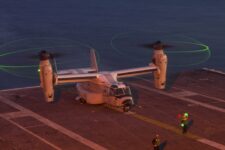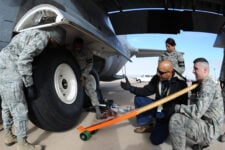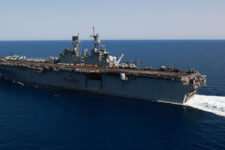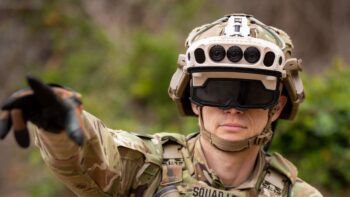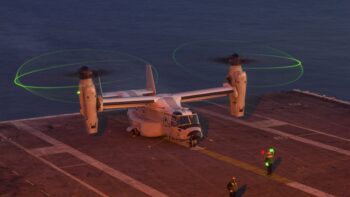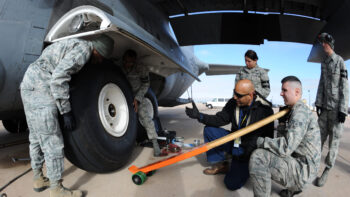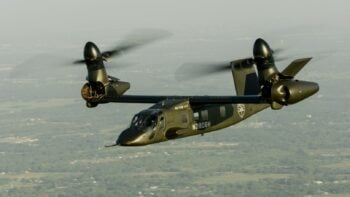
Streaks in the sky form at sunset behind the U.S. Capitol Building on November 13, 2019 in Washington, DC. (Photo by Mark Makela/Getty Images)
WASHINGTON — The Senate today confirmed Gen. Randy George and Gen. Eric Smith to respectively lead the Army and Marine Corps, a temporary thaw for a group of over 300 officers whose career advancements are still frozen by a blanket hold from Alabama Republican Sen. Tommy Tuberville.
The votes came Thursday afternoon and passed by a wide margin. George, whose nomination was up first, was confirmed 96-1, and was sworn in as the 41st chief within hours. Smith’s nomination was similarly greenlit by senators on a 96-0 vote. Smith and George, who have been leading their respective branches in an acting capacity due to their stalled nominations, can now formally assume their new posts.
The votes followed a move by Sen. Majority Leader Chuck Schumer, D-N.Y., to invoke cloture on Wednesday, setting in motion a process to end debate on the nominees and tee them up for a vote. Air Force Gen. CQ Brown’s nomination to be the next Chairman of the Joint Chiefs was the first vote up, passing the Senate Wednesday evening by an 83-11 margin.
Brown will take the reins of the Joint Chiefs next month when the incumbent chairman, Army Gen. Mark Milley, steps down. After serving as the first Black service chief, Brown will be the second Black chairman of the Joint Chiefs and will join Defense Secretary Lloyd Austin as the first pair of Black men to lead the Pentagon.
RELATED: 3 acting chiefs, 3 black boxes: Army, Navy to join Marines without confirmed chief
Schumer’s hand was seemingly forced by Tuberville, who had moved to file cloture for the nominees yesterday. Tuberville has long insisted that despite his hold — which he launched in March as a protest over a Pentagon policy that provides leave and travel reimbursements for servicemembers seeking an abortion — nominees could still be advanced individually through a floor vote, the process by which the trio of officers were confirmed.
But a similar outcome doesn’t appear likely for what the Pentagon says are 312 officers whose promotions are still in limbo. Nominees are typically bundled together and passed unanimously in large groups, a process Tuberville blocked. The Congressional Research Service reported in August would take some 89 days of Senate floor time to advance every one of the officers — based on a smaller list than is currently stalled out.
Taking to the Senate floor yesterday, the Alabama senator vowed that his hold would remain in place unless the Pentagon backtracks on the abortion policy. A continued stalemate would likely leave the Navy and Air Force without confirmed chiefs — Navy Adm. Lisa Franchetti’s and Air Force Gen. David Allvin’s nominations have yet to receive a vote out of the Senate Armed Services Committee — and similarly leave the hundreds of remaining officers tapped for promotion waiting in the wings.
The New Chiefs
George and Smith are now stepping into the top uniformed positions of their respective services in the midst of reorganization, modernization programs and a challenging recruiting environment.
For George, the relatively new Army Futures Command is poised to begin fielding a host of new capabilities in the coming years including a new Precision Strike Missile, the M10 Booker combat vehicle, and mid-range capability weapon, while also continuing development on an XM30 Mechanized Infantry Combat Vehicle (formerly known as the Optionally Manned Fighting Vehicle), two new helicopters and more.
In addition to rolling out new weapons to the force, George and other service leaders are discussing force combat power changes.
“We’re going to have to change how we’re organized…. That’s one of the things that we have to go down the focus areas and ask four-star commanders and sergeant majors to take a look at and review,” George told an audience on Sept. 12 at a Maneuver Warfighter Conference. “How are we structured and what needs to adjust based on the advances that we’re seeing? We are [also] going to have to change how we train.”
Smith, meanwhile, now takes on the fate of Force Design 2030, a controversial reworking of the Marines launched by Gen. David Berger, Smith’s predecesor. As a career infantryman and advocate of the former commandant’s plans, Smith’s tenure could be what solidifies the change towards becoming smaller and more nimble in support of naval expeditionary warfare operations.
Just before stepping down, Berger gave his final update to the plan and set the stage for several initiatives for Smith to take up, including a new reconnaissance battalion and work on hypersonic weapons.
Brown, for his part, will face a litany of obstacles once sworn in including fractions inside Congress growing weary of continued financial support to Ukraine’s military, a looming government shutdown or continuing budget resolution, and the ongoing US military pivot to the Indo-Pacific region.
Senator raises defense industry concerns over Boeing’s potential Spirit buy
Sen. Jerry Moran, R-Kan., says defense primes need more clarity about what happens to their programs if Boeing buys Spirit.

